Everything You Need to Know About Balsamic Vinegar
From the real deal that costs as much as $200 an ounce to a whole host of other derivative products.
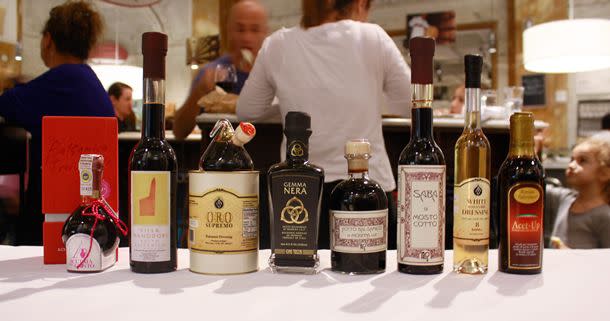
Olivia Butrick / Eataly
Balsamic vinegars at Eataly New York's Eccellenze counter.In 1046, the Holy Roman Emperor Henry III was given a silver bottle containing a celebrated vinegar while passing through a town on his way to his coronation. The record of this visit is thought to be the first written reference to balsamic vinegar, a condiment once known only to those in the Emilia-Romagna region of what is now modern Italy, and produced only in the provinces of Reggio Emilia —where Henry III was visiting —and neighboring Modena.
Today, balsamic vinegar is known to cooks around the world and available to shoppers everywhere. It can sell for as much as $200 an ounce, or as cheaply as three dollars for a 16 ounce bottle. But how can one vinegar offer such a dramatic price range? How can one condiment be fit for an emperor and for a salad dressing? The answer, of course, is that there isn't just one balsamic vinegar. But understanding the differences takes a bit of work.
Traditional Balsamic Vinegar
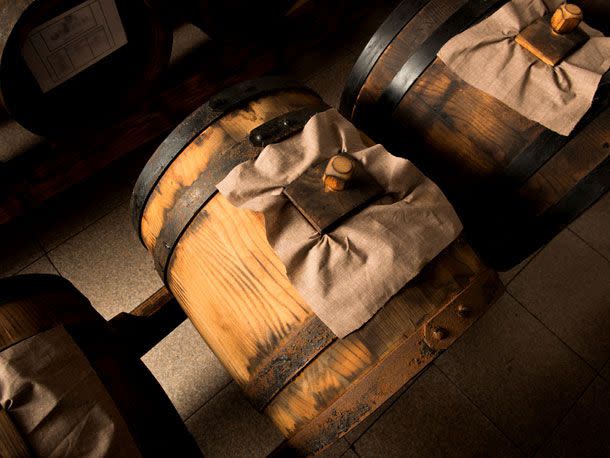
Gua / Shutterstock
Balsamic aging in barrelsTraditional balsamic vinegar is the granddaddy of balsamic vinegars. To this day it is only made in Reggio Emilia and Modena, Italy, using traditional methods, and production is overseen from beginning to end by a special certification agency.
Traditional balsamic vinegar begins with grape must —whole pressed grapes complete with juice, skin, seeds and stems. The must from sweet white locally grown and late-harvested grapes —usually Lambrusco or Trebbiano varieties— is cooked over a direct flame until concentrated by roughly half, then left to ferment naturally for up to three weeks, and then matured and further concentrated for a minimum of 12 years in a "batteria," or five or more successively smaller aging barrels. These barrels are made of different types of wood such as oak, chestnut, cherry, juniper, and mulberry, so that the vinegar can take on the complex flavors of the casks.
Once a year the vinegar is bottled from the smallest cask in the sequence. Each cask is then topped up with vinegar from the next cask up, with the largest cask getting filled with the new yield. None of the casks are ever completely drained. This aging process is similar to the solera process used for fine sherries, ports, sweet wines, and Spanish brandies. The vinegar gets thicker and more concentrated as it ages because of evaporation that occurs through the walls of the barrels—the vinegar in the smallest barrel will be much thicker and more syrupy than the liquid in the successively larger barrels.
Because of the multi-barrel process, it takes complex math to gauge the average age of the bottled product, so instead a tasting commission of five expert judges convenes to taste the vinegars and determine an appropriate grade, and no age is printed on the label. In Reggio Emilia, traditional balsamics are graded affinato (fine), with a red cap, which roughly corresponds to a 12-year vintage; vecchio (old), with a silver cap, which roughly corresponds to a 15-20 year vintage; or extra vecchio (extra old), with a gold cap, which roughly corresponds to a 20-25 year vintage. In Modena there's just affinato, with a white cap, or extra vecchio, with a gold cap.
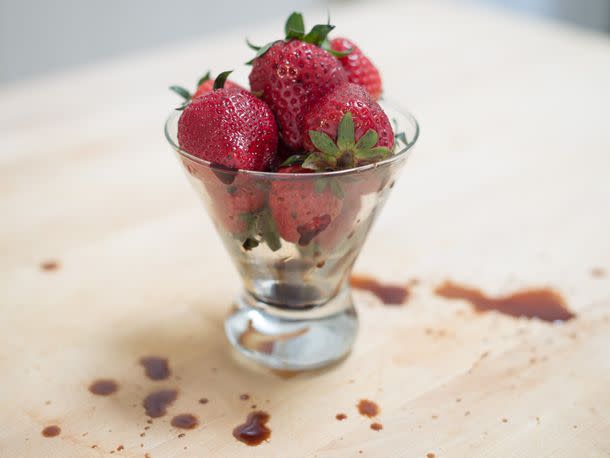
Paul Hillier / PAUL HILLIER PHOTOGRAPHY
Balsamic vinegar and strawberries.Color and Texture: Traditional balsamic vinegar is glossy, viscous, and dark brown, though it captures light beautifully. It moves like syrup, and has a velvety texture on the tongue.
Flavor: A rich, complex sweetness that explodes in the mouth with notes of fig, molasses, cherry, chocolate, or prune. Traditional balsamic should pick up the flavors of the wood it matured in, and may have a slight smokiness. Traditional balsamic offers a mellow tartness rather than a strong acidity.
Identification: Traditional balsamic vinegar is always labelled Aceto Balsamico Tradizionale and carries a D.O.P. ("Denominazione di Origine Protetta") stamp — a European Union certification that guarantees an ingredient's quality, production, and place of origin. The only ingredient is grape must. Traditional balsamic contains naturally occurring sulphites; none should be added.
Traditional balsamic is sold in wax-sealed bottles with unique identifying numbers. Traditional balsamic from Modena is only sold in a bulb-shaped 100ml bottle. If it's from Reggio Emilia it's only sold in a 100ml bottle shaped like an inverted tulip. If it's from anywhere else, it's not traditional balsamic vinegar.
Use: Traditional balsamic is not a cooking ingredient — heating it will kill its distinctive bouquet — and it would be wasted as an ingredient in a salad dressing. Instead, use it where it can shine. Try putting a few drops on fresh berries, Parmigiano-Reggiano cheese, or creamy desserts like panna cotta, zabaglione, or vanilla ice cream. Traditional balsamic can be used at the end of the cooking. It's excellent drizzled over traditional veal scaloppine, a rich risotto, or the Italian stew bollito misto. It's also great over grilled meats and seafood. Add about a teaspoon per person just before serving to get the best of its flavor.
In Italy really good balsamic is also drunk as a palette cleanser, aperitif or digestif, especially on special occasions such as weddings. The name "balsamic" connotes the vinegar's original use as a tonic, or "balm."
Storage: Traditional balsamic vinegar will keep indefinitely, but store in a cool dark place to best preserve the complexity of its flavors, and keep away from other pungent ingredients. Balsamic vinegar will not continue to mature in the bottle.
Tip
Traditional balsamic is sold in wax-sealed bottles with unique identifying numbers. Traditional balsamic from Modena is only sold in a bulb-shaped 100ml bottle. If it's from Reggio Emilia it's only sold in a 100ml bottle shaped like an inverted tulip. If it's from anywhere else, it's not traditional balsamic vinegar.
Condimento Balsamico

Paul Hillier / PAUL HILLIER PHOTOGRAPHY
Condimento BalsamicoBecause the production of traditional balsamic is so tightly defined and regulated, there is a certain appreciable clarity to its categorization. Dig any further into the world of balsamic vinegar and things get more confusing.
"Condimento" is a term that exists to cover balsamic vinegars made in the traditional manner that can't receive the "traditional" designation, usually because they weren't produced under appropriate supervision or because they didn't meet the standard for maturity. Often they're excellent balsamic vinegars made outside of Modena and Reggio Emilia, or vinegars made by tradizionale producers that have only been aged for three or five or seven years.
These products are generally much cheaper than tradizionale balsamics, but often still excellent quality, so they may represent better value for money. However, because the title "condimento" is not a protected designation the term can be found on lower grade vinegar as well, and some version of "condimento" or "condiment" may appear on balsamic-like products.
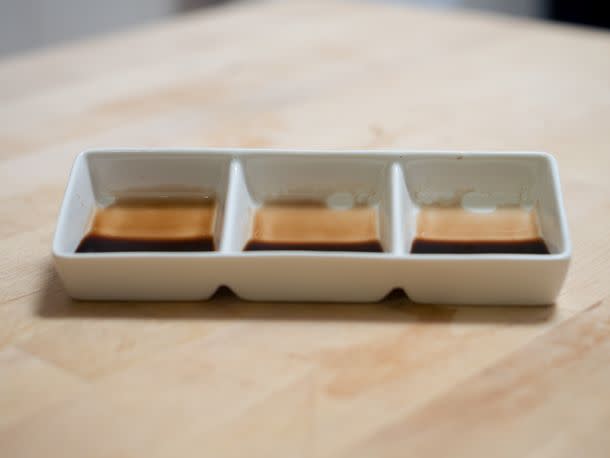
Paul Hillier / PAUL HILLIER PHOTOGRAPHY
Note the different viscosity of condimento balsamico (left), aged I.G.P. balsamic vinegar (center) and supermarket-grade I.G.P. balsamic vinegar (right).Color and Texture: Because balsamic is cooked down and then further condensed by maturation, it tends to have greater viscosity and depth of color the older it is and the richer its flavor. A good condimento should really coat the walls of a glass.
Flavor: Condimento lacks the woody notes and lingering complexity of traditional balsamic, but should still offer a wonderful mix of acidity, sweetness, and leathery, cherry flavors.
Identification: Condimento will not have D.O.P. stamp on the label, but it should carry an I.G.P. stamp — "indicazione geografica protetta," or protected geographical indication. Condimento may also carry the seal of the Consorzio di Balsamico Condimento, a body set up to monitor condimento grade balsamics, and a good indicator of quality. Condimento should be relatively expensive — around $40 for a good size bottle. The most important thing to check to be sure of a good condimento is the ingredients list. If grape must is the only ingredient, that's a great sign. Some condimentos may contain a little wine vinegar to balance the acidity, but if wine vinegar is the first ingredient, you're looking at generic vinegar sweetened with balsamic must, not balsamic must balanced with a little vinegar.
If there's a family name and a real address on the label, that's a good sign, because it suggests small scale production. Some condimentos are made by tradizionale balsamic producers, and that's a very good sign.
Usage: Condimento should be used exactly as a traditional balsamic is used, with the advantage that you can use it more liberally because it's much cheaper! That also means that you can use it for a salad dressing, though you should make it the dominant note.
Storage: As with traditional balsamic, condimento will last forever but should be kept away from strong flavors and strong light.
Tip
The most important thing to check to be sure of a good condimento is the ingredients list. If grape must is the only ingredient, that's a great sign. Some condimentos may contain a little wine vinegar to balance the acidity, but if wine vinegar is the first ingredient, you're looking at generic vinegar sweetened with balsamic must, not balsamic must balanced with a little vinegar.
Balsamic Vinegar of Modern IGP
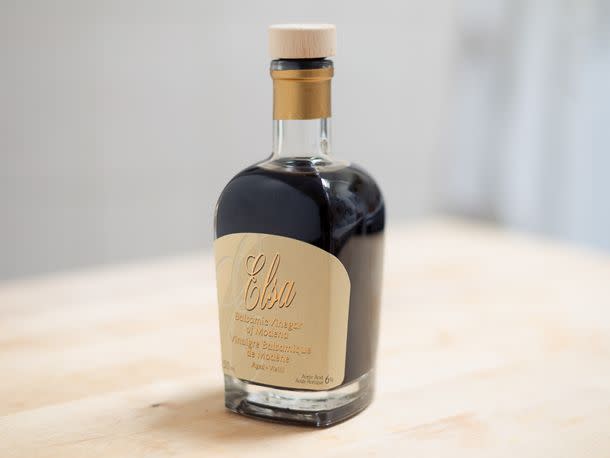
Paul Hillier / PAUL HILLIER PHOTOGRAPHY
Aged balsamic vinegar of Modena.The first balsamic vinegars sold in the US arrived courtesy of one Chuck Williams, the founder of Williams-Sonoma, in 1977. They were presumably the real deal, but that was the start of a boom for imported balsamic from Modena that would soon see demand outstrip supply.
This surge in popularity led to a rise in derivative products, which in turn led to the introduction of a protected designation for true traditional balsamic vinegar. But the D.O.P. designation only protects the very best; it doesn't offer any level of distinction among mass market balsamics.
That's where the I.G.P. designation comes in. Introduced by the European Union in 2009, I.G.P. guarantees that the product is made from grape varietals typical of Modena (Albana, Ancellotta, Fortana. Lambrusco, Montuni, Sangiovese, and Trebbiano), though the grapes can be from anywhere and only need to be processed in Modena. This is the only way balsamic vinegar of Modena can be produced in volumes sufficient to meet demand.
The vinegar is cooked in pressurized vats and aged for at least two months in large wooden barrels. There is no fermentation stage. Balsamic Vinegar of Modena I.G.P. must contain wine vinegar to bring its acidity to at least 6%, and can contain up to 50% wine vinegar, often both aged and young. It may contain thickening agents, caramel, or other colorants to make it more like real balsamic. The balance of ingredients can create balsamic vinegars as cheap as $5 or as expensive as $50.
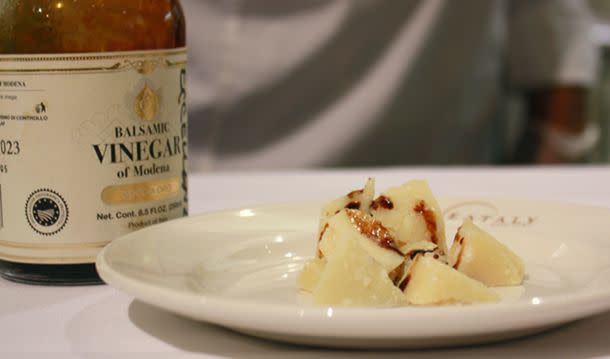
Olivia Butrick / Eataly
Balsamic vinegar with Parmigiano-Reggiano.Color and Texture: The appearance of balsamic vinegar of Modena I.G.P. is hugely variable both because additives are permitted and because the ratio of wine vinegar to grape must is variable. If the label doesn't list any thickeners and the vinegar seems thick, it probably has a high percentage of grape must.
Flavor: I.G.P. balsamic has a higher acidity, and that's strongly reflected in the taste. This isn't a complex condiment, but closer to a standard vinegar with a touch of sweetness. These vinegars vary substantially in quality, which may be reflected in the price. Darker vinegars ought to be sweeter. Expensive vinegars ought to be more complex.
Identification: Other than the I.G.P. designation and yellow-and-blue I.G.P. stamp (which shows two furrowed hillsides in a ring of stars), there should never be too much shown on the label of an I.G.P. balsamic. The EU banned the use of potentially misleading language and numbers on these labels, to stop producers from fooling consumers into thinking they were vintage products. The word "aged" can appear on an I.G.P. balsamic label if the product has matured in wood barrels for more than three years.
Some producers use their own rating systems to distinguish between balsamic vinegars in their own line. For example, the four-leaf system uses leaves to represent the density and sweetness of the vinegar, but the quality indicated by these ratings is not consistent from one producer to the next. I.G.P. certification also appears on most condimento balsamics, as mentioned above.
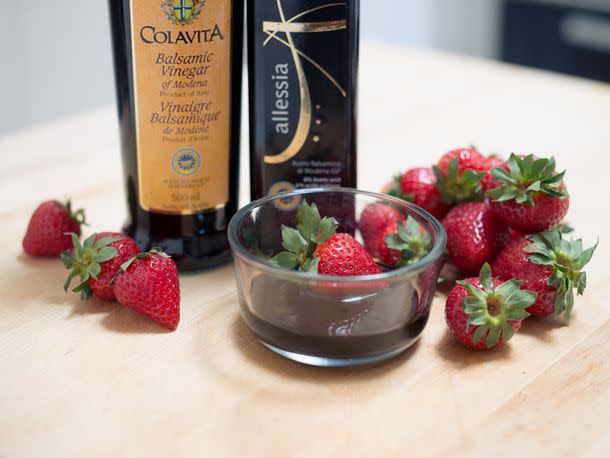
Paul Hillier / PAUL HILLIER PHOTOGRAPHY
Supermarket balsamic vinegar I.G.P. and strawberries.Usage: This grade of balsamic vinegar is also known as salad balsamic (balsamic insalata), which gives you a clue as to how it's used; it's the go-to balsamic for a flavorful salad dressing. It's also a great flavor enhancer for soups and stews, and ideal as a marinade. Unlike fancy balsamics, it's actually perfect for cooking with, because it can reduce down. In fact, one of the simplest things to do with salad balsamic is to boil it in a saucepan with some sugar to create a cheap balsamic syrup. Lighter salad balsamics are especially tart, and ideal for vinaigrettes and dips. Darker salad balsamics are sweeter and make better marinades and finishing drizzles. The darkest varieties are the ones to experiment with on ice cream or berries, though they won't offer the same rapturous pleasure as the real thing.
Storage: This grade of balsamic also keeps indefinitely.
Imitation Balsamic
While balsamic vinegar of Modena I.G.P. at least uses wine vinegar and cooked must, there are some vinegars on shelves that use the word "balsamic" that are really just vinegar with sweetener and coloring. They may be made with wine vinegar, white vinegar, or cider vinegar, and they're industrially-produced to emulate the texture and flavor of balsamic, at a fraction of the price. Some of these vinegars may claim to have been made in Italy, but without an I.G.P. stamp, the ingredients could come from anywhere.
Some balsamic-style vinegars are produced outside of Italy— e.g. in Spain, Greece, France, the U.S., or Canada. Some of these approach the quality of good balsamic vinegar, and the clues are always in the ingredients. If the ingredients only list cooked must, it's a high-end balsamic imitator. If it contains cooked must and vinegar, it's closer to an I.G.P. While these vinegars are nothing like traditional balsamic, they do have a place in the kitchen in things like salad dressings and marinades. Check ingredients and taste around to find one you like.
Tip
Some of these vinegars may claim to have been made in Italy, but without an I.G.P. stamp, the ingredients could come from anywhere.
Balsamic-Inspired Products
The popularity of balsamic vinegar has led to a mini-industry of derivative products. We mention some of the major ones here, but it should be noted that high quality balsamic would never be wasted in a derivative product.
Balsamic glaze: A thick syrup generally made with grape must, I.G.P. balsamic vinegar, guar gum, and xanthan gum. It's essentially a way to give cheap balsamic the consistency of expensive balsamic so that it can be used in the same way - as a drizzle or finishing sauce.
Balsamic ketchup: Ketchup that switches out white vinegar for balsamic vinegar. This adds some tang to the ketchup but sacrifices the complexity of balsamic.
Balsamic pearls: A strange artifact of the molecular gastronomy craze, balsamic pearls are balsamic vinegar of Modena I.G.P. transformed into tiny black balls with the help of a gelling agent and other additives. A fancy garnish if you don't trust yourself to drizzle elegantly.
Balsamic syrup: Another name for balsamic glaze.
Flavored balsamic: Balsamic vinegar infused with flavor additives such as lemon, herbs, vanilla, fruit, berries, etc. Good balsamic doesn't need extra flavor any more than a good wine, so if a balsamic vinegar has flavor enhancements that might be taken as a bad sign. We recommend making your own infused balsamic, such as our recipe for strawberry balsamic sauce.
Saba: Regarded as the ancestor of balsamic vinegar, and popular in Roman times, saba is a sweet syrup of slow-cooked concentrated grape must. It's unfermented, but may spend some months maturing in a barrel. Vincotto is a similar condiment from southeastern Italy. They both make great alternative to balsamic vinegar.
White balsamic: Sweet white wine vinegar. White balsamic is slow-cooked to avoid caramelization, and there is no requirement for maturation. Not a true balsamic at all, because caramelization is a necessary part of the production of real balsamic.
With thanks to Joanne Kelly and Caitlin Addlesperger at New York gourmet retailer Eataly, and Angelo Tramonti at Ontario-based importer and distributor Sarafino.
May 2014
Read the original article on Serious Eats.
